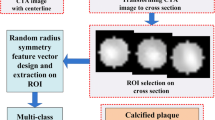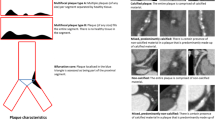Abstract
Purpose
A guided review process to support manual coronary plaque detection in computed tomography coronary angiography (CTCA) data sets is proposed. The method learns the spatial plaque distribution patterns by using the frequent itemset mining algorithm and uses this knowledge to predict potentially missed plaques during detection.
Materials and methods
Plaque distribution patterns from 252 manually labeled patients who underwent CTCA were included. For various cross-validations a labeling with missing plaques was created from the initial manual ground truth labeling. Frequent itemset mining was used to learn the spatial plaque distribution patterns in form of association rules from a training set. These rules were then applied on a testing set to search for segments in the coronary tree showing evidence of containing unlabeled plaques. The segments with potentially missed plaques were finally reviewed for the existence of plaques. The proposed guided review was compared to a weighted random approach that considered only the probability of occurrence for a plaque in a specific segment and not its spatial correlation to other plaques.
Results
Guided review by frequent itemset mining performed significantly better (p < 0.001) than the reference weighted random approach in predicting coronary segments with initially missed plaques. Up to 47% of the initially removed plaques were refound by only reviewing 4.4% of all possible segments.
Conclusions
The spatial distribution patterns of atherosclerosis in coronary arteries can be used to predict potentially missed plaques by a guided review with frequent itemset mining. It shows potential to reduce the intra- and inter-observer variability.
Similar content being viewed by others
References
Jougla E (2003) Health Statistics—Atlas on mortality in the European Union. European Communities
Shinohara M, Yamashita T, Tawa H et al (2008) Atherosclerotic plaque imaging using phase-contrast X-ray computed tomography. Am J Physiol Heart Circ Physiol 294(2): H1094–H1100. doi:10.1152/ajpheart.01149.2007
Alkadhi H, Scheffel H, Desbiolles L et al (2008) Dual-source computed tomography coronary angiography: influence of obesity, calcium load, and heart rate on diagnostic accuracy. Eur Heart J 29(6): 766–776. doi:10.1093/eurheartj/ehn044
Leschka S, Alkadhi H, Plass A et al (2005) Accuracy of MSCT coronary angiography with 64-slice technology: first experience. Eur Heart J 26(15): 1482–1487. doi:10.1093/eurheartj/ehi261
Scheffel H, Alkadhi H, Leschka S et al (2008) Low-dose CT coronary angiography in the step-and-shoot mode: diagnostic performance. Heart 94(9): 1132–1137. doi:10.1136/hrt.2008.149971
Achenbach S, Moselewski F, Ropers D et al (2004) Detection of calcified and noncalcified coronary atherosclerotic plaque by contrast-enhanced, submillimeter multidetector spiral computed tomography: a segment-based comparison with intravascular ultrasound. Circulation 109(1): 14–17. doi:10.1161/01.CIR.0000111517.69230.0F
Hausleiter J, Meyer T, Hadamitzky M et al (2006) Prevalence of noncalcified coronary plaques by 64-slice computed tomography in patients with an intermediate risk for significant coronary artery disease. J Am Coll Cardiol 48(2): 312–318. doi:10.1016/j.jacc.2006.02.064
Hoffmann U, Moselewski F, Nieman K et al (2006) Noninvasive assessment of plaque morphology and composition in culprit and stable lesions in acute coronary syndrome and stable lesions in stable angina by multidetector computed tomography. J Am Coll Cardiol 47(8): 1655–1662. doi:10.1016/j.jacc.2006.01.041
Leber AW, Knez A, Becker A et al (2005) Visualising noncalcified coronary plaques by CT. Int J Cardiovasc Imaging 21(1):55–61. formerly Cardiac Imaging. doi:10.1007/s10554-004-5337-7
Leber AW, Knez A, von Ziegler F et al (2005) Quantification of obstructive and nonobstructive coronary lesions by 64-slice computed tomography: a comparative study with quantitative coronary angiography and intravascular ultrasound. J Am Coll Cardiol 46(1): 147–154. doi:10.1016/j.jacc.2005.03.071
Saur SC, Alkadhi H, Desbiolles L et al (2008) Automatic detection of calcified coronary plaques in computed tomography data sets. In: Medical image computing and computer-assisted intervention—MICCAI 2008. Springer, New York. doi:10.1007/978-3-540-85988-8_21
Agrawal R, Imieliński T, Swami A (1993) Mining association rules between sets of items in large databases. In: Proceedings of the 1993 ACM SIGMOD international conference on Management of data. Washington, D.C., pp 207–216
Quack T, Ferrari V, Leibe B et al (2007) Efficient mining of frequent and distinctive feature configurations. In: International conference on computer vision. Rio de Janeiro, Brasil. doi:10.1109/ICCV.2007.4408906
Chen Q, Chen Y-P (2006) Mining frequent patterns for AMP-activated protein kinase regulation on skeletal muscle. BMC Bioinformatics 7(1): 394. doi:10.1186/1471-2105-7-394
Huang Y, Li H, Hu H et al (2007) Systematic discovery of functional modules and context-specific functional annotation of human genome. Bioinformatics 23(13): i222–i229. doi:10.1093/bioinformatics/btm222
Wright A, Sittig DF (2006) Automated development of order sets and corollary orders by data mining in an ambulatory computerized physician order entry system. In: AMIA annual symposium proceedings
Couturier O, Delalin H, Fu H et al (2004) A three-step approach for STULONG database analysis: characterization of patients’ groups. In: ECML-PKDD discovery challenge
Cheruvu PK, Finn AV, Gardner C et al (2007) Frequency and distribution of thin-cap fibroatheroma and ruptured plaques in human coronary arteries: a pathologic study. J Am Coll Cardiol 50(10): 940–949. doi:10.1016/j.jacc.2007.04.086
Virmani R, Burke AP, Farb A et al (2006) Pathology of the vulnerable plaque. J Am Coll Cardiol 47(8): C13–C18. doi:10.1016/j.jacc.2005.10.065
Pregowski J, Tyczynski P, Mintz GS et al (2006) Intravascular ultrasound assessment of the spatial distribution of ruptured coronary plaques in the left anterior descending coronary artery. Am Heart J 151(4): 898–901. doi:10.1016/j.ahj.2005.06.019
Maehara A, Mintz GS, Castagna MT et al (2001) Intravascular ultrasound assessment of the stenoses location and morphology in the left main coronary artery in relation to anatomic left main length. Am J Cardiol 88(1): 1–4. doi:10.1016/S0002-9149(01)01575-2
Wang JC, Normand S-LT, Mauri L et al (2004) Coronary artery spatial distribution of acute myocardial infarction occlusions. Circulation 110(3): 278–284. doi:10.1161/01.CIR.0000135468.67850.F4
Shimada Y, Courtney BK, Nakamura M et al (2006) Intravascular ultrasonic analysis of atherosclerotic vessel remodeling and plaque distribution of stenotic left anterior descending coronary arterial bifurcation lesions upstream and downstream of the side branch. Am J Cardiol 98(2): 193–196. doi:10.1016/j.amjcard.2006.01.073
Beckman JA, Ganz J, Creager MA et al (2001) Relationship of clinical presentation and calcification of culprit coronary artery stenoses. Arterioscler Thromb Vasc Biol 21(10): 1618–1622. doi:10.1161/hq0901.095554
Ehara S, Kobayashi Y, Yoshiyama M et al (2004) Spotty calcification typifies the culprit plaque in patients with acute myocardial infarction: an intravascular ultrasound study. Circulation 110(22): 3424–3429. doi:10.1161/01.CIR.0000148131.41425.E9
Fujii K, Carlier SG, Mintz GS et al (2005) Intravascular ultrasound study of patterns of calcium in ruptured coronary plaques. Am J Cardiol 96(3): 352–357. doi:10.1016/j.amjcard.2005.03.074
Hong M-K, Mintz GS, Lee CW et al (2007) Plaque ruptures in stable angina pectoris compared with acute coronary syndrome. Int J Cardiol 114(1): 78–82. doi:10.1016/j.ijcard.2006.01.008
Austen W, Edwards J, Frye R et al (1975) A reporting system on patients evaluated for coronary artery disease. Report of the ad hoc committee for grading of coronary artery disease, council on cardiovascular surgery, American Heart Association. Circulation (51):5–40
Borgelt C, Kruse R (2002) Induction of association rules: a priori implementation. In: Conference on Computational Statistics
Kerwin W, Han C, Chu B et al (2001) A quantitative vascular analysis system for evaluation of atherosclerotic lesions by MRI. In: Medical image computing and computer-assisted intervention—MICCAI. pp 786–794
Frangi AF, Niessen WJ, Nederkoorn PJ et al (2000) Three-dimensional model-based stenosis quantification of the carotid arteries from contrast-enhanced MR angiography. In: Proceedings of IEEE workshop on mathematical methods in biomedical image analysis. doi:10.1109/MMBIA.2000.852367
Anderson RW, Stomberg C, Hahm CW et al (2007) Automated classification of atherosclerotic plaque from magnetic resonance images using predictive models. Biosystems 90(2): 456–466. doi:10.1016/j.biosystems.2006.11.005
Wolf RL, Wehrli SL, Popescu AM et al (2005) Mineral volume and morphology in carotid plaque specimens using high-resolution MRI and CT. Arterioscler Thromb Vasc Biol 25(8): 1729. doi:10.1161/01.ATV.0000173311.39867.65
Author information
Authors and Affiliations
Corresponding author
Rights and permissions
About this article
Cite this article
Saur, S.C., Alkadhi, H., Desbiolles, L. et al. Guided review by frequent itemset mining: additional evidence for plaque detection. Int J CARS 4, 263–271 (2009). https://doi.org/10.1007/s11548-009-0290-5
Received:
Accepted:
Published:
Issue Date:
DOI: https://doi.org/10.1007/s11548-009-0290-5




